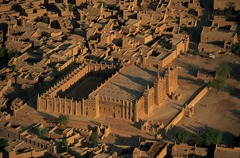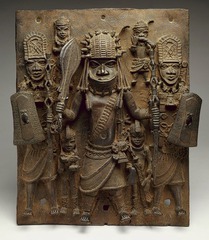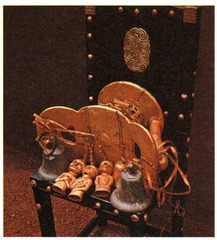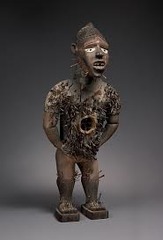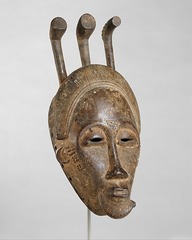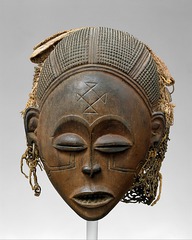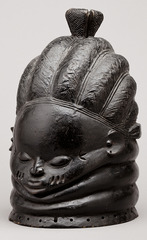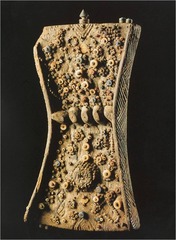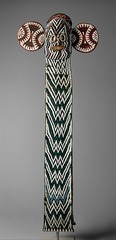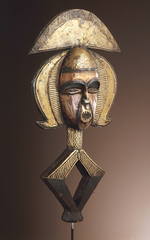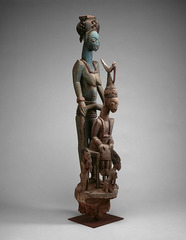Conical tower and circular wall of Great Zimbabwe. Southeastern Zimbabwe. Shona peoples. c. 1000-1400 C.E. Coursed granite blocks.
N: Conical Tower and Circular Wall of Great Zimbabwe
D: 1000-1400 C.E P/S: Kush
A: People of Zimbabwe
PA: Unknown
OL: Southeastren Zimbabwe
M: Carsed granite blocks, soapstone T: Architecture
F: Trading place, mutlifunction
C: Early human settlement
DT: Stone wall
M:Place for interaction of the early zimbabwe people
Great Mosque of Djenne. Mali. Founded c. 1200 C.E.; rebuilt 1906-1907. Adobe.
Name: Great Hall of the Bulls
Date: 13000 B.C.E.
Artist: Uknown
Patron: Uknown
Original Location: Lascaux, France
Material: Chalk on Rock
P/S: Cave Drawing
Technique: Side Front view
Descriptive Terms: side front view, overcrossing drawings
Context: Most likely whenever they saw something in the wild they drew it in a cave
Meaning: The meaning was probably to record what types of animals were in their hunting area
Wall plaque, from Oba's Palace. Edo peoples, Benin (Nigeria). 16th century C.E. Cast brass.
N: Wall Plaque from Oba's Palace
D: 16th century C.E.
P/S: African/ Kush
A: Edo People
Pa: High Class Edo People
OL: Benin (Nigeria)
M: Cast Brass, Ivory, Terracotta and Wood
T: Metallurgy
F: Serve as a Power and Social Status Symbol
C: Only used my royals and wealthy
DT: Plaque, Engraving
M: Honor Oba King
Sika dwa kofi (Golden Stool). Ashanti peoples (south central Ghana). c. 1700 C.E. Gold over wood and cast-gold attachments.
N: Golden Stool
D: c.1700 P/S: African Art
A: Ashanti People
PA: Osei Tutu
OL: South central Ghana
M: Gold, bells, wood T: Divine Funiture
F: House the spirit of the Ashante nation
C: Descended down from heaven to the King
DT: Throne, Images on it
M: Symbolic of a chieftain's leadership
Ndop (portrait figure) of King Mishe miShyaang maMbul. Kuba peoples (Democratic Republic of the Congo). c. 1760-1780 C.E. Wood.
Name: nDop
Date: c1760 C.E.
Artist: Skilled worker of tribe
Patron: King Mishe miShyaang maMbul
Original Location: Republic of congo
Material: Wood
Technique: 3d portrait
Descriptive Terms: power figure smooth symbol showed as leader
Meaning: The meaning is to serve as a power structure which they believe had power that they could use from the leader of the tribe
Power figure (Nkisi n'kondi). Kongo peoples (Democratic Republic of the Congo). c. late 19th century C.E. Wood and metal.
N: Power Figure
D: 19th century AD P/S: Modern Art/Impressionism
A: unknown
P: Lila Acheson Wallace
OL: Democratic Republic of Congo or Angolop
M: Wood, metal, resin, enamel
T: Wood sculpture
F: The piece was sought to inspire awe, to intimidate, and to evoke power without bounds.
C: African power figures are among the ubiquitous genres identified with African Art. Conceived to house specific mystical forces they were collaborative creations of Congo sculptors and ritual specialists.
DT: Wood sculpture, Spiky, Rough.
M: The power was represented as a presiding authority and enforcing lord or king.
Portrait mask (Mblo). Baule peoples (Côte d'Ivoire). Late 19th to early 20th century C.E. Wood and pigment.
Female (Pwo) mask. Chokwe peoples (Democratic Republic of the Congo). Late 19th to early 20th century C.E. Wood, fiber, pigment, and metal.
N: Female (Pwo) Mask
D: Late 19th to 20th century C.E
P/S: African/ Kush
A: Chowke People
Pa: Unknown
OL: Congo
M:Wood, Fiber, Pigment, and Metal
T: Wood Scupture
F: symbol of reaching adulthood and motherhood
C: Thought to believe fertility and prosperity
DT: Mask
M: Honors female ancestors
Bundu mask. Sande Society, Mende peoples (West African forests of Sierra Leone and Liberia). 19th to 20th century C.E. Wood, cloth, and fiber.
N: Bundu Mask
D: 19th to 20th century C.E
P/S: African/ Kush
A: Mende People
Pa: Unknown
OL: Sierra Leone/ Liberia
M: Wood, Cloth, and Fiber
T: Wood Sculpture
F: Worn for Initiation or Celebration
C: Worn Only by Women For Celebration
DT: Polished and Blackened Hardwood, Costume
M: Spirit of Fecundity and Incarnation of Female Waters
Ikenga (shrine figure). Ibgo peoples (Nigeria). c. 19th to 20th century C.E. Wood. (Page 188).
Lukasa (memory board). Mbudye Society, Luba peoples (Democratic Republic of the Congo). c. 19th to 20th century C.E. Wood, beads, and metal.
N: Lukasa
D: 19th to 20th century C.E
P/S: African/ Kush
A: Luba People
PA: Luba Royalty
OL: Congo
M: Wood, Beads, and Metal
T: Mnemonic Device
F: Memory Board
C: Source of Knowledge, History and Rule for the society
DT: Sculpture and Memory Board
M: Preserve Luba Culture
Aka elephant mask. Bamileke (Cameroon, western grassfields region). c. 19th to 20th century C.E. Wood, woven raffia, cloth, and beads.
N: Aka Elephant Mask
D: 350 B.C.E- 1000 C.E P/S:Aksum
A: African society members
Pa:Higher ranking members of society
OL: Bamileke, Cameroon
M: Wood, woven cloth, and beads T: Mask
F: Worn only at funerals, celebrations, or important events
C: Only high ranking members of society had wore and owned these
DT: Geometric patterns
M: Power symbol
Reliquary figure (nlo bieri). Fang peoples (southern Cameroon). c. 19th to 20th century C.E. Wood.
Name: Reliquary Figure (Nlo Bieri)
Date: 19th-20th Century P/S: Tribal Art
Author: The Fang
Original Location: South Cameroon
Material: Wood, palm oil
Technique: Sculpture
Function: To serve as a protective guard
Context: These figures were used to guard houses, special treasures, churches, etc.
Descriptive Term: Balanced symmetry, application of straight lines and sinuous curves
Meaning: Shows that youthful vigor and mature serenity coexist in harmony (as evidenced by a calm facial expression paired with the muscular body structure).
Veranda post: equestrian figure and female caryatid. Olowe of Ise (Yoruba peoples). Before 1938 C.E. Wood and pigment.
Name: Veranda Post: Equestrian Figure and Female Caryatid
Date: 19th-20th Century P/S: Yoruba Art
Artist: Olowe of Ise
Original Location: Africa (most likely, Yorubaland)
Material: Wood, pigment
Technique: Sculpting
Function: to show a ruler's dependence on others
Context: In Africa, it was common for rulers to go to their wives for advice and consult
Descriptive Terms: linear motifs, exaggerated proportions
Meaning: To emphasize the importance of the wife-specifically the wives of rulers- and the roles they carry

